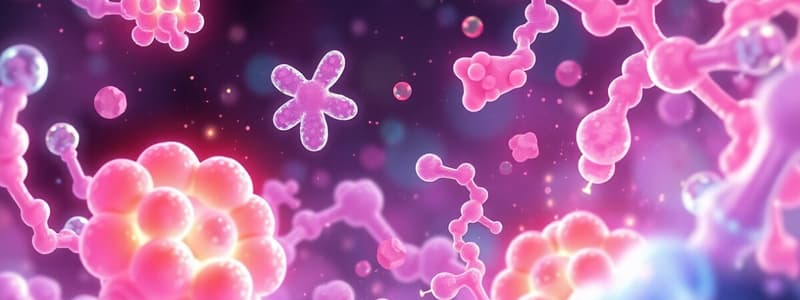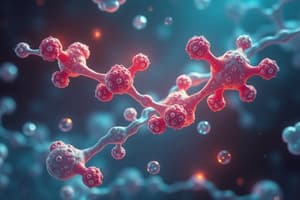Podcast
Questions and Answers
Which of the following are characteristics of aminoglycosides?
Which of the following are characteristics of aminoglycosides?
- Excellent activity against Mycobacteria
- Inhibit translation by binding to 16S rRNA (correct)
- Bacteriostatic in action
- High bioavailability
What is a common adverse effect of rifamycin?
What is a common adverse effect of rifamycin?
- Dizziness
- Visual disturbances
- Nephrotoxicity
- Hepatotoxicity (correct)
Which macrolide is noted for its long terminal half-life?
Which macrolide is noted for its long terminal half-life?
- Erythromycin
- Rifaximin
- Azithromycin (correct)
- Clarithromycin
What mechanism do aminoglycosides use to achieve their bactericidal effect?
What mechanism do aminoglycosides use to achieve their bactericidal effect?
Which of the following is NOT a method of resistance associated with aminoglycosides?
Which of the following is NOT a method of resistance associated with aminoglycosides?
Which of the following statements about macrolides is true?
Which of the following statements about macrolides is true?
What characteristic distinguishes rifamycin from aminoglycosides?
What characteristic distinguishes rifamycin from aminoglycosides?
Which of the following adverse effects is associated with aminoglycosides?
Which of the following adverse effects is associated with aminoglycosides?
What is a common mechanism of resistance against rifamycin?
What is a common mechanism of resistance against rifamycin?
Which statement accurately describes the pharmacokinetics of aminoglycosides?
Which statement accurately describes the pharmacokinetics of aminoglycosides?
What is the primary mechanism of action for macrolides?
What is the primary mechanism of action for macrolides?
Which characteristic is true regarding the pharmacological properties of rifamycin?
Which characteristic is true regarding the pharmacological properties of rifamycin?
Which of the following statements accurately describes aminoglycosides?
Which of the following statements accurately describes aminoglycosides?
What is a common adverse effect associated with rifamycin medications?
What is a common adverse effect associated with rifamycin medications?
What type of activity do aminoglycosides exhibit against Enterobacteriaceae?
What type of activity do aminoglycosides exhibit against Enterobacteriaceae?
Flashcards are hidden until you start studying
Study Notes
Aminoglycosides
- Mechanism of action: Bind to the 16S rRNA of the 30S ribosomal subunit, causing misreading of mRNA and leading to cell death.
- Bactericidal: Directly kill bacteria.
- Low bioavailability: Poorly absorbed from the gut.
- Renal elimination: Primarily excreted via the kidneys.
- Short half-lives: Quickly removed from the body.
- Excellent activity: Effective against Enterobacteriaceae, Acinetobacter, Pseudomonas, and other Gram-negative rods (GNR).
- Good activity: Effective against many Gram-positive cocci (GPC) in combination with cell-wall active agents.
- Suboptimal tissue penetration: Limited ability to reach tissues.
- Adverse effects: Nephrotoxicity (kidney damage) and ototoxicity (hearing loss).
- Resistance mechanisms:
- Enzymatic inactivation: Enzymes break down the antibiotic.
- Altered membrane permeability: Bacteria prevent the antibiotic from entering the cell.
- Target site mutation: Changes in the ribosome structure prevent antibiotic binding.
Rifamycin
- Mechanism of action: Prevents transcription by blocking the RNA polymerase enzyme.
- Bactericidal: Directly kill bacteria.
- Key members: Rifampin, Rifabutin, Rifapentine, Rifaximin.
- Broad spectrum: Effective against Gram-positive, Gram-negative bacteria, and Mycobacteria.
- Strong CYP450 inducers: Increase the activity of CYP450 enzymes, which metabolize many drugs.
- Main adverse effects:
- Rash.
- Hypersensitivity reactions.
- Hepatotoxicity (liver damage).
- Discoloration of secretions (orange-red).
- Rifapentine: Has an extended half-life.
- Rifaximin: No systemic absorption, mainly targets the gut.
Macrolides
- Mechanism of action: Inhibit translation by binding the 23s rRNA of the 50s ribosomal subunit.
- Bacteriostatic: Inhibit bacterial growth, but do not directly kill them.
- High intracellular concentrations: Reach high levels inside cells.
- Highly bioavailable: Well absorbed from the gut.
- Excellent lung penetration: Effective in treating respiratory infections.
- Poor CNS penetration: Do not readily cross the blood-brain barrier.
- Azithromycin: Has a long terminal half-life.
- Eliminated hepatically or biliary: Primarily eliminated via the liver.
- Spectrum of activity: Streptococcus spp., atypical pathogens, some GNR including Haemophilus influenzae, Moraxella catarrhalis.
Aminoglycosides
- Aminoglycosides inhibit translation by binding to 16S rRNA of the 30S ribosomal subunit. This causes misreading of the mRNA sequence and results in the production of faulty proteins, leading to cell death.
- Commonly used examples include Gentamicin, Tobramycin, Amikacin, Neomycin, Streptomycin, and Plazomicin.
- These drugs are bactericidal, meaning they kill bacteria directly.
- Due to their low bioavailability, they are typically administered intravenously or intramuscularly.
- They are primarily eliminated through the kidneys, with short half-lives.
- Aminoglycosides exhibit excellent activity against Enterobacteriaceae, Acinetobacter, Pseudomonas, and other Gram-negative bacteria.
- They also demonstrate good activity against many Gram-positive bacteria when used in synergy with cell-wall active agents.
- However, their penetration into tissues is suboptimal.
- Nephrotoxicity and ototoxicity are significant adverse effects associated with aminoglycoside use.
- They are primarily used for serious gram-negative infections, including those caused by Pseudomonas.
- Resistance mechanisms include enzymatic inactivation, altered membrane permeability, and mutations in the target site.
Rifamycins
- Rifamycins inhibit transcription by blocking the activity of bacterial DNA-dependent RNA polymerase. This prevents the synthesis of mRNA, ultimately halting protein synthesis.
- They are bactericidal and have a broad spectrum of activity, including against Gram-positive and Gram-negative bacteria, as well as Mycobacteria.
- Common examples include Rifampin, Rifabutin, Rifapentine, and Rifaximin.
- Rifamycins are potent inducers of the cytochrome P450 (CYP450) system, an enzyme system responsible for metabolizing many drugs. This can lead to drug interactions.
- Potential adverse effects include rash, hypersensitivity, hepatotoxicity, and discoloration of secretions (orange-red).
- Rifapentine has an extended half-life, allowing for less frequent dosing.
- Rifaximin is not absorbed systemically, making it suitable for treating gastrointestinal infections.
Macrolides
- Macrolides inhibit translation by binding to the 23S rRNA of the 50S ribosomal subunit, preventing the elongation of the polypeptide chain.
- They are generally bacteriostatic, meaning they inhibit bacterial growth but do not directly kill bacteria.
- Macrolides can achieve high intracellular concentrations, making them effective against intracellular pathogens.
- They exhibit high bioavailability and excellent lung penetration, but limited penetration into the central nervous system.
- Azithromycin has a long terminal half-life, allowing for once-daily dosing.
- Elimination occurs primarily through hepatic or biliary pathways.
- Macrolides are effective against a variety of bacteria, including Streptococcus spp., atypical pathogens (e.g., Mycoplasma), and some Gram-negative bacteria like Haemophilus influenzae and Moraxella catarrhalis.
Aminoglycosides
- Aminoglycosides are a class of antibiotics that inhibit protein synthesis by binding to the 16S rRNA of the 30S ribosomal subunit, leading to misreading of mRNA and ultimately cell death.
- This mechanism makes them bactericidal, meaning they kill bacteria.
- Aminoglycosides have low bioavailability, meaning they are poorly absorbed from the gastrointestinal tract.
- They are primarily eliminated by the kidneys, with short half-lives.
- Aminoglycosides have excellent activity against many Gram-negative bacteria (GNR), including Enterobacteriaceae, Acinetobacter, Pseudomonas, and others.
- They also have good activity against many Gram-positive bacteria (GPC) when used in synergy with cell-wall active agents.
- However, they have suboptimal penetration of tissues.
- Aminoglycosides are associated with adverse effects such as nephrotoxicity and ototoxicity.
- Despite these risks, they are valuable for treating serious gram-negative infections, particularly pseudomonal infections.
- Resistance to aminoglycosides can develop due to:
- Enzymatic inactivation of the antibiotic by bacterial enzymes
- Altered membrane permeability that prevents the drug from entering the bacterial cell
- Mutations in the target site, the 16S rRNA, that prevent the drug from binding
Rifamycins
- Rifamycins are a class of antibiotics that block transcription, preventing the synthesis of messenger RNA (mRNA) and ultimately bacterial protein synthesis.
- They exhibit bacteriacidal activity.
- Rifampin, Rifabutin, Rifapentine, and Rifaximin are commonly used rifamycins.
- They have a broad spectrum of activity, including Gram-positive, Gram-negative, and Mycobacteria.
- Rifamycins are potent inducers of CYP450, an enzyme system that metabolizes many drugs.
- Common adverse effects include:
- Rash
- Hypersensitivity reactions
- Hepatotoxicity
- Discoloration of secretions (orange-red)
- Rifapentine has an extended half-life, allowing for less frequent dosing.
- Rifaximin is not absorbed systemically and is used for treating bowel infections.
Macrolides
- Macrolides are a class of antibiotics that inhibit protein synthesis by binding to the 23s rRNA of the 50s subunit of the ribosome.
- This mechanism makes them bacteriostatic, meaning they inhibit bacterial growth but do not directly kill bacteria.
- Macrolides achieve high intracellular concentrations, making them effective against intracellular pathogens.
- They are highly bioavailable and have excellent lung penetration, making them useful for treating respiratory infections.
- However, they have poor penetration into the central nervous system (CNS).
- Azithromycin, a macrolide, has a long terminal half-life, allowing for once-daily dosing.
- Macrolides are eliminated hepatically or biliarily.
- They have a broad spectrum of activity, including Streptococcus spp, atypical pathogens, and some Gram-negative bacteria such as H. influenzae and M. catarrhalis.
Studying That Suits You
Use AI to generate personalized quizzes and flashcards to suit your learning preferences.




